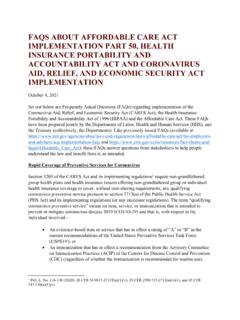Transcription of Addressing Social Determinants of Health in Primary Care
1 The EveryONE ProjectTMAdvancing Health equity in every community Health inequalities and the Social Determinants of Health are not a footnote to the Determinants of Health . They are the main issue. Sir Michael Marmot 2018 american academy of family physiciansAddressing Social Determinants of Health in Primary Careteam-based approach for advancing Health equitypage 2 2018 american academy of family physicianstable of contentsIntroduction ..3 Definitions of Key Terms ..3 Section 1: Develop a Practice Culture that Values Health Equity ..3 Understand Your Patient s Community ..4 Understand How Social Determinants of Health Impact Health Outcomes (Quickfacts).
2 4 Addressing Implicit Bias ..5 Building Cultural Competence and Proficiency ..5 Health Literacy and Interpretation Services ..5 Section 2: Develop a Team-based Approach for Addressing Social Determinants of Health ..6 Step 1: Identify Opportunities to Address Social Determinants of Health ..7 Step 2: Evaluate Patient and Workflow ..7 Step 3: Define a New System ..8 Step 4: Identify Barriers and Plan for Change ..9 Step 5: Measure and Celebrate Success ..9 Step 6: Finalize Your Team-based implementation Plan ..10 Conclusion ..10 References ..12 The EveryONE ProjectTMAdvancing Health equity in every communityDISCLAIMERD ownload these resources* for use in workplaces, Health systems, and other places in your community . *The EveryONE Project materials featured here are copyrighted by the American Academy of Family Physicians (AAFP).
3 The EveryONE Project is a pending registered trademark of the AAFP . By downloading any of these materials, you agree that the AAFP is the owner of The EveryONE Project materials and that your use of The EveryONE Project materials will only be used for the purposes of education and advancing Health equity in every community . The EveryONE Project materials may not be modified in any way and may not be used to state or imply the AAFP s endorsement of any goods or services .ACKNOWLEDGMENTThe AAFP would like to thank the following members for reviewing the Socia Determinants of Health (SDOH) screening tool and guide:Margot Savoy, MD, MPH, FAAFP | Venis T . Wilder, MD | David O Gurek, MD, FAAFPHOP18071112 Supported in part by a grant from the AAFP FoundationintroductionThe American Academy of Family Physicians (AAFP) define Social Determinants of Health (SDOH) as the conditions under which people are born, grow, live, work, and age.
4 1 SDOH factors include socioeconomic status; racism and discrimination; poverty and income inequality; and the lack of community resources, among others .2 They account for as much as 55% of Health outcomes .3 A substantial proportion of Health care to America s underserved populations is provided by family physicians, who see the impact of SDOH every day . Family physicians and their Health care teams are critical in Addressing their patients SDOH because Primary care is a natural point of integration among clinical care , public Health , behavioral Health , and community-based services .4,5 You can incorporate information about patient s SDOH into the bio-psychosocial model to promote continuous healing relationships and comprehensive, whole-person care . This implementation guide provides information and resources for family physicians and their practice teams to address their patients SDOH and how to better advance Health equity.
5 Designed in two sections, the first section addresses how family physicians and their Health care teams can develop a practice culture that values Health equity . The second section provides resources to develop a planned, team-based approach to address SDOH . Work through this guide with your Health care team to identify opportunities to improve how you and your team address patients SDOH . Definitions of Key TermsSocial Determinants of Health (SDOH): SDOH include the conditions under which people are born, grow, live, work, and age .1 For the purposes of this implementation guide, the term refers to patients individual level and immediate Social needs . Health equity: Health equity is the attainment of the highest level of Health for all people . Achieving Health equity requires valuing everyone equally with focused and ongoing societal efforts to address avoidable inequalities, historical and contemporary injustices, and the elimination of Health and Health care disparities.
6 7 For the purposes of this implementation guide, the term refers to differences in Health status between different population groups that are avoidable, unjust, and unfair . Community-based resources: Community-based resources refer to organizations that provide programs and services that assist individuals with their Social and economic needs . For the purposes of this implementation guide, the term is broad in scope and entails organizations that provide financial assistance, supplementary food assistance, and job placement and training, among a variety of other services .section 1: develop a practice culture that values Health equityPractices with a culture that values Health equity strive to understand their patients lives and context . These practices look for ways to help their patients overcome hurdles to their Health and Health care .
7 While there are a variety of ways to establish and enrich a culture of Health equity in your practice, key strategies include: Understanding your patient s community. What barriers do your patients face to living a healthy life? What resources do your patients have access to in their community? Demographic, environmental, and public Health data can illuminate issues that your patients may not even know they face . Learning about how Social factors influence Health . Social factors influence Health through a complex web of causation . Understanding the different mechanisms can help improve patient care . Confronting implicit bias in your practice. Everyone holds implicit biases . Work with your Health care team to uncover these biases and identify opportunities to address them to improve patient care .
8 Empowering the whole Health care team. Addressing SDOH is complex . All members of the Health care team have unique skills that can help to better address the Social barriers to Health that your patients face . Developing processes that promote Health literacy. Improve how you present information to your patients so that they understand and can follow your instructions .page 3 2018 american academy of family physiciansTeam-based Primary CareAddressing Social Determinants of Health (SDOH) requires a team-based approach. The instructions and suggestions outlined in this implementation guide are intended to be conducted by all the Health care team members in your practice based on their role. Recognition of the unique skills of the members of your Health care team is key to providing comprehensive care and identifying how all team members can contribute to Addressing SDOH in your EveryONE ProjectTMAdvancing Health equity in every communityunderstand patient s communitiesEach of these strategies is described in greater detail in this guide, with additional resources provided in the AAFP s SDOH Toolkit (www.)
9 Aafp .org/EveryONE) .Understand Your Patient s CommunityYou have probably heard catch phrases like, your zip code matters more than your genetic code, or place matters . The reason for this is that poor Health outcomes tend to cluster in disadvantaged neighborhoods . Some factors in disadvantaged neighborhoods, like living conditions, may be apparent to patients from these neighborhoods . Other factors, such as environmental hazards or discriminatory policies may go unnoticed by your patients . In these cases, patients will not be able to tell you or your practice team about these issues . There are a variety of databases and community efforts that can help fill this gap, including: County Health Rankings & Roadmaps: The annual county Health rankings measure vital Health factors, including high school graduation rates, obesity, smoking, unemployment, access to healthy foods, quality of air and water, income inequality, and teen births in nearly every county in the U.
10 S . The annual rankings reveal a snapshot of how Health is influenced by where we live, learn, work, and play . They provide a starting point of change in communities .8 (www .countyhealthrankings .org) HealthLandscape: HealthLandscape is an interactive, web-based mapping tool that allows you and your practice team to combine, analyze, and display information in ways that promote better understanding of Health and the forces that affect it . (www .healthlandscape .org) Local Health Department s Community Health Assessment: City and county Health departments are charged with developing Health data profiles to help residents understand Health concerns and drivers in their community . While community Health assessments vary by how comprehensive they are, an ideal assessment includes information on morbidity and mortality, risk factors, quality of life, community assets, and Health inequities.


















